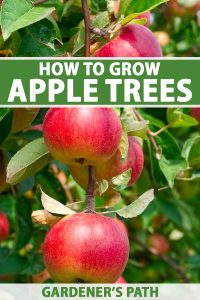13 of the Best Flowering Dogwood Varieties
If you love flowering dogwoods (Cornus florida), you should check out these 13 exceptional cultivars to add to your landscape. Learn more on Gardener's Path.
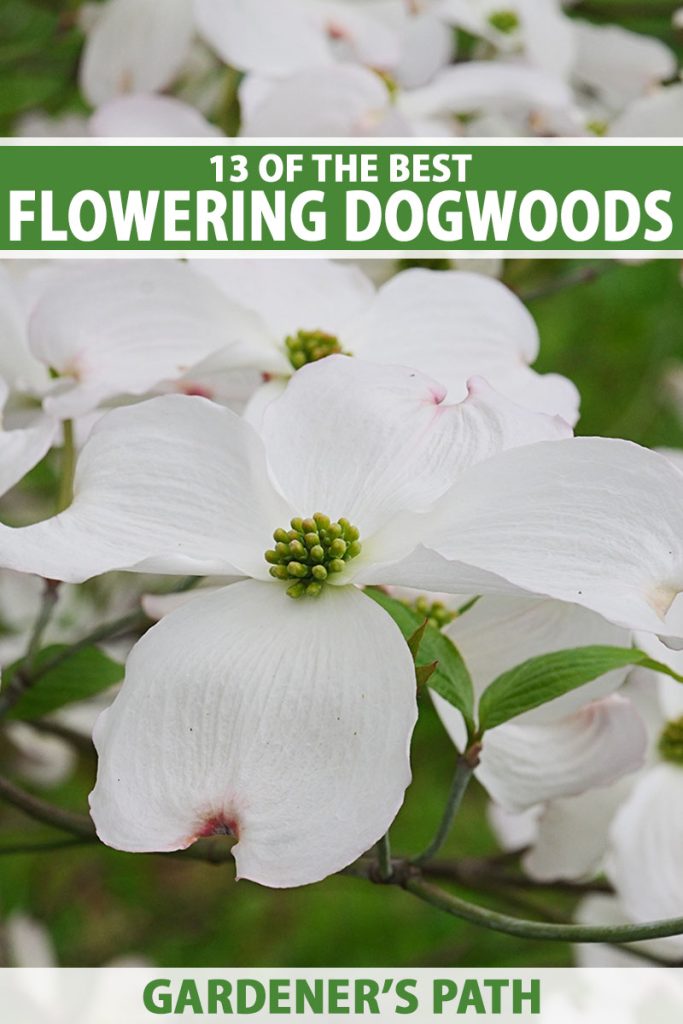
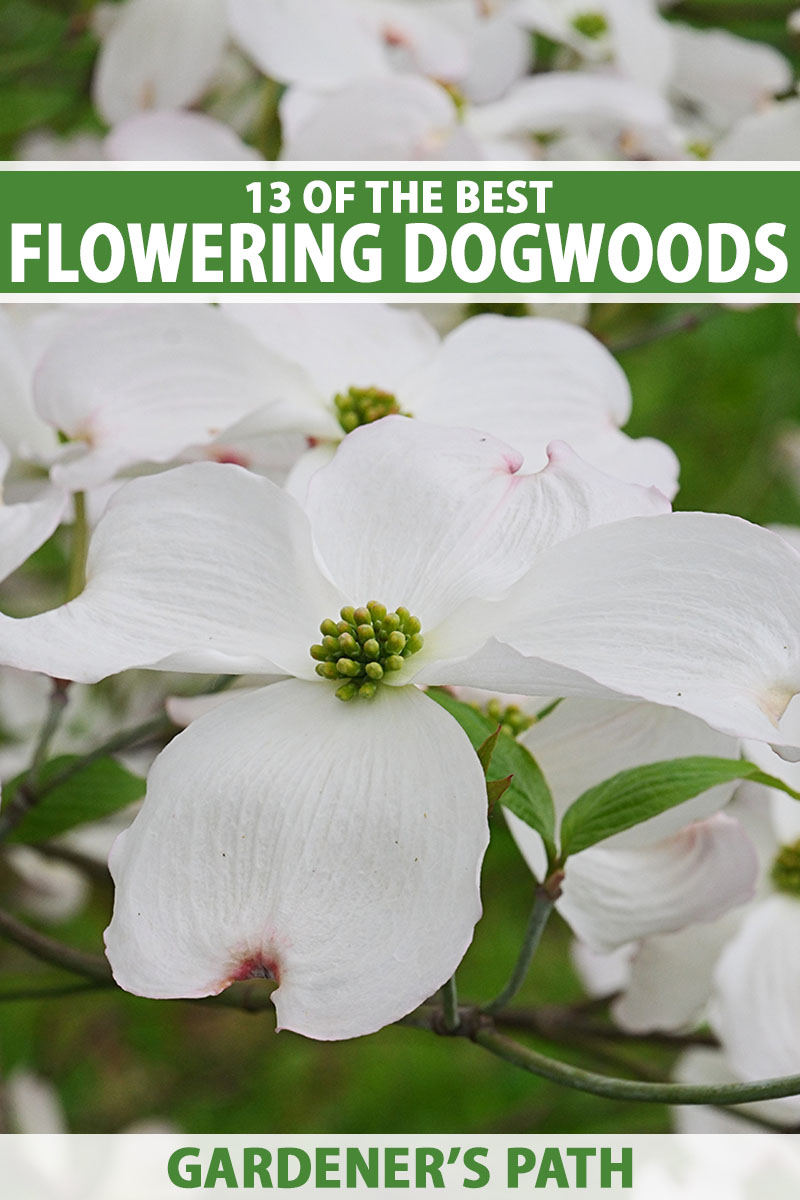
Arguably the crown jewel of the Cornus genus, the flowering dogwood (C. florida) offers plenty of beauty in standard species mode, no cultivars required.
But for even more ornamental options, why not check out some cultivated C. florida varieties?
With over a hundred cultivars of flowering dogwood available in various sizes, forms, and colors, a gardener has quite the choice to make.
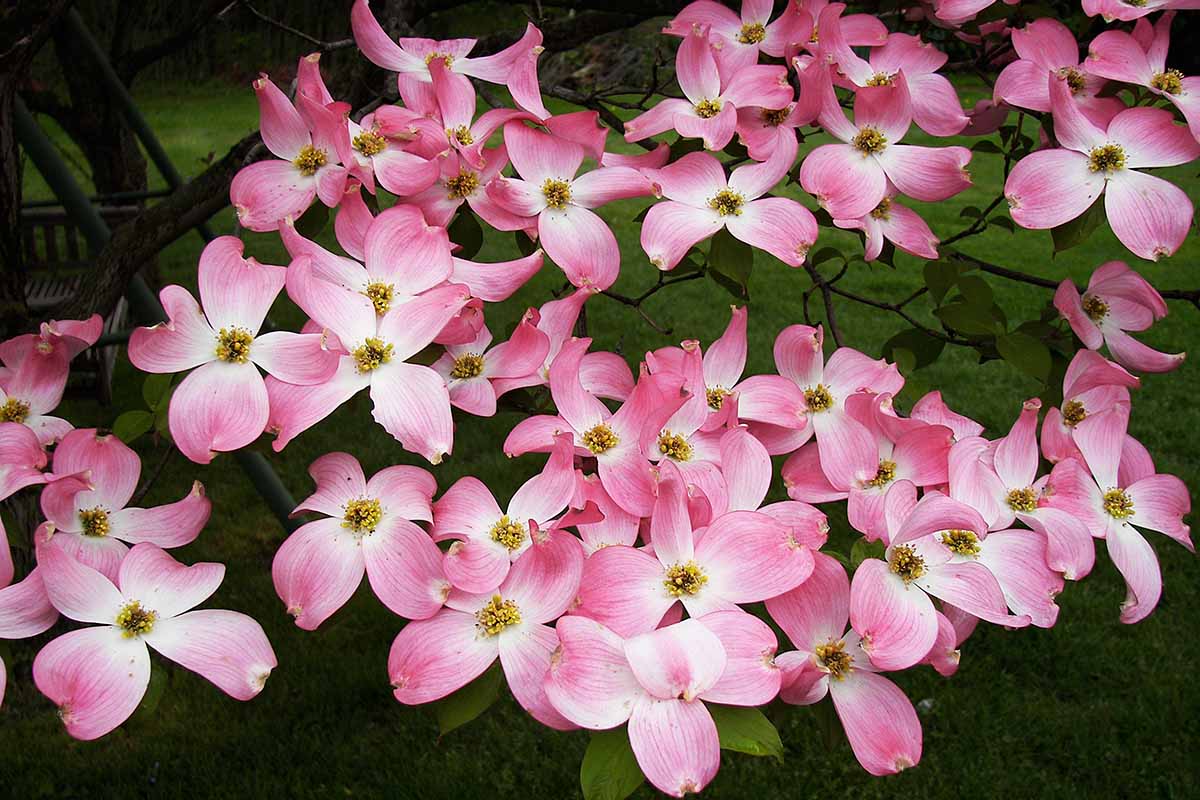

We link to vendors to help you find relevant products. If you buy from one of our links, we may earn a commission.
Add assorted growth rates, bloom times, and disease resistance to the mix, and that choice becomes even harder.
To help you on this journey, you’ll need a guide. Not necessarily an old, wizened, and sage guide like Gandalf or Yoda, though. I’ll have to do, at least to start.
With this guide to 13 of the best flowering dogwood cultivars, we’ll be separating the wheat from the chaff, the cream from the non-creamy crop, the extraordinary from the extra ordinary.
At least, it reveals what I consider to be the 13 best. Everyone’s entitled to their opinion, right?
Here’s the lineup:
Best Flowering Dogwoods
- Appalachian Spring
- Cherokee Chief
- Cherokee Daybreak
- Cherokee Princess
- Cherokee Sunset
- Cloud 9
- Compacta
- Plena
- Red Pygmy
- Spring Grove
- Stellar
- Welchii
- Xanthocarpa
Before we begin, it’s important to know the sort of tree you want, along with where you intend on planting it.
And if you need a quick primer on flowering dogwoods and how to grow them, check out our article.
Also, I’ll be using the terms bloom/flower and bract pretty much interchangeably.
Even though they’re modified leaves rather than true flower petals, the leaf bracts of flowering dogwoods pretty much function as flowers, at least ornamentally.
Okay, time to talk trees! And shrubs, if we’re being technical.
1. Appalachian Spring
Since cultivars are either intentionally bred or accidentally discovered, they often have epic, superhero-esque origin stories. ‘Appalachian Spring’ is a perfect example.
In the 1970s, Discula destructiva – aka Discula or dogwood anthracnose – was discovered in the US after arriving from origins unknown.
Infecting and severely reducing native Cornus populations, this deadly disease was well on its way to dooming American dogwoods.
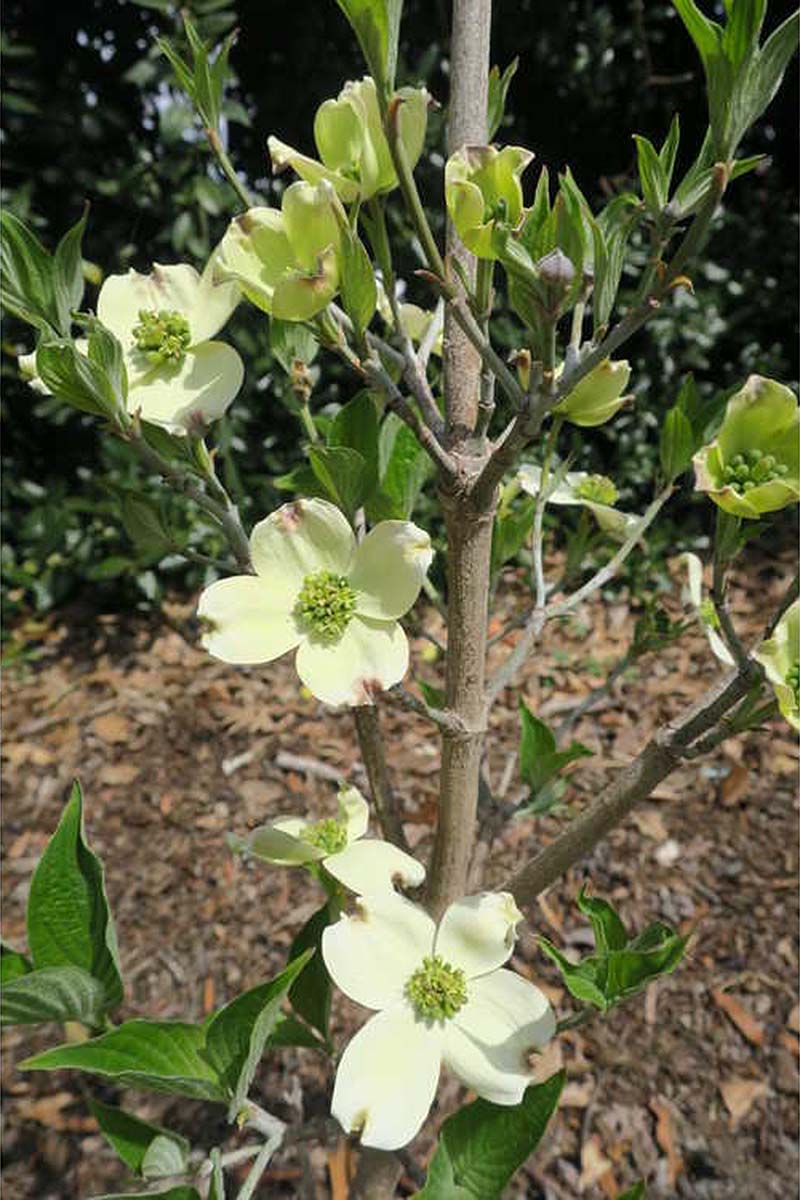

But all was not lost. In 1990, a certain C. florida specimen was found growing wild at Camp David on Catoctin Mountain in Maryland by the University of Tennessee’s Mark Windham.
Wielding a moderate to strong resistance to the D. destructiva fungus, this tree was used in the University’s dogwood breeding program to yield ‘Appalachian Spring’ – a fast-growing, white-bracted cultivar with larger-than-standard fruits, an upright habit, a height and spread of 20 to 30 feet, and an exceptionally strong resistance to Discula anthracnose.
If you’re looking for a heroically tough dogwood, ‘Appalachian Spring’ is the variety for you.
2. Cherokee Chief
A standard flowering dogwood has white flower bracts, each with a red notch at its apex.
‘Cherokee Chief’ offers a delightful inversion of this, with ruby-red flower bracts that are notched with white. These bracts are also white where their bases meet the true flowers, which draws the eye.
Discovered and introduced into the trade by Issac J. Hawkersmith of Winchester, Tennessee, ‘Cherokee Chief’ has a height and spread of 15 to 30 feet, as well as reddish growth on new leaves.
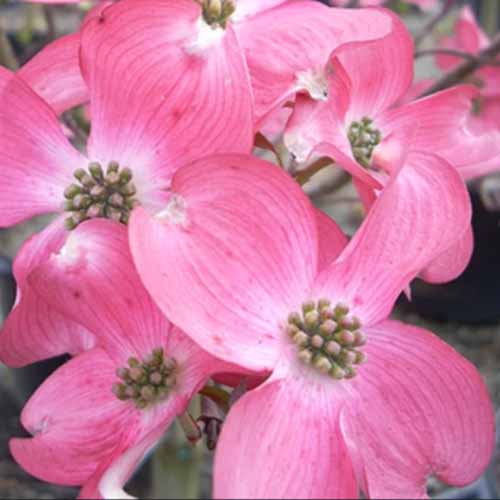

‘Cherokee Chief’
It’s also worth noting that this tree’s redness is really, really rich, making it a very popular red-bracted variety, if not the most popular. It truly is the chief.
To purchase a ‘Cherokee Chief’ of your own, head on over to Planting Tree.
3. Cherokee Daybreak
A white-flowering variety from Commercial Nursery in Decherd, Tennessee, Cherokee Daybreak™ (aka ‘Daybreak’) features olive green leaves, each with yellowish-white variegation that both holds its color and fails to scorch easily in hot conditions, which is quite impressive for a variegated plant.
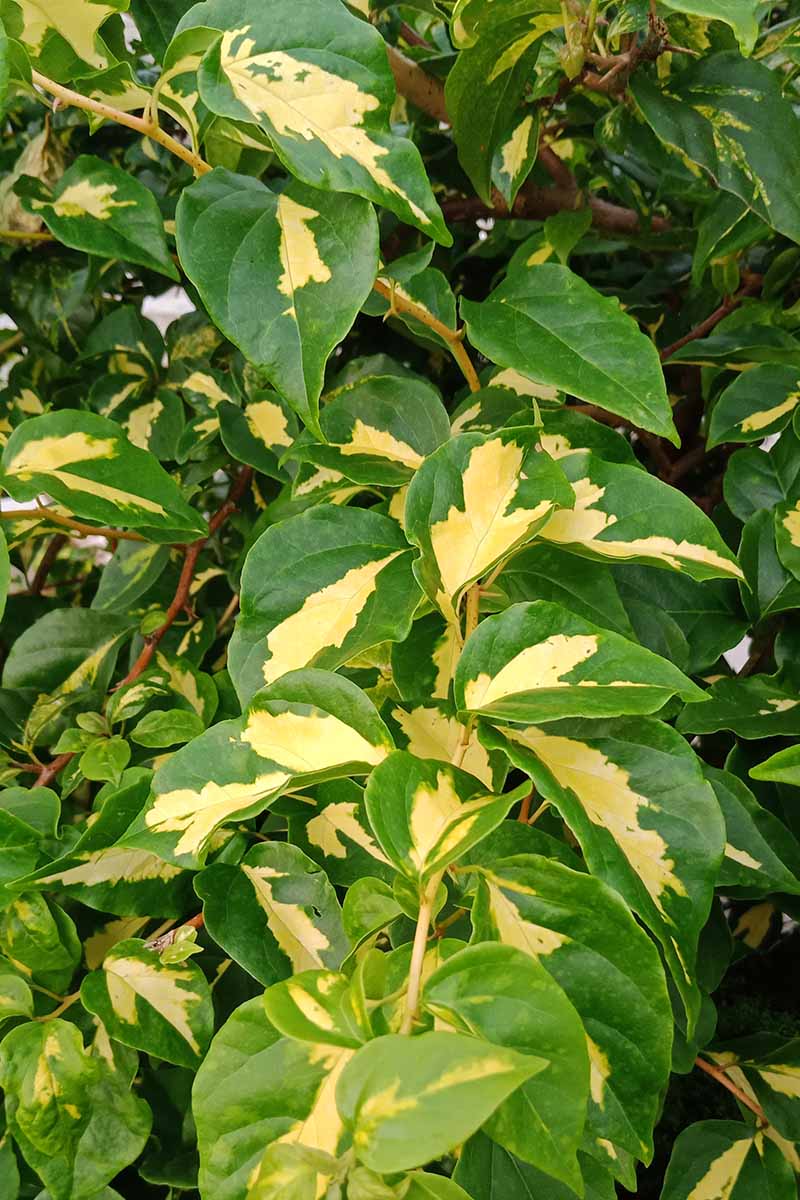

Additionally, this tree boasts fantastic resistance to anthracnose – another impressive feat for foliage with variegation.
It has a vigorous growth rate and an upright habit that reaches mature heights and widths of 15 to 20 feet.
Come autumn, the leaf variegation becomes pinkish, while the greener parts of the foliage turn an impressive red.
4. Cherokee Princess
Another white-flowering variety, ‘Cherokee Princess’ is simply better than the standard. End of story.
Reaching mature heights and spreads of 20 feet, this cultivar has resistance against spot anthracnose and canker – two conditions that can really mess up a dogwood.
Additionally, it begins its bud break in early spring, even earlier than a regular flowering dogwood does.
Aesthetically, this tree boasts heavier flowering and larger-than-normal blooms that reach five inches in diameter.
This, in combination with the profuse blooming, makes for a brilliant, almost blindingly white canopy in springtime.
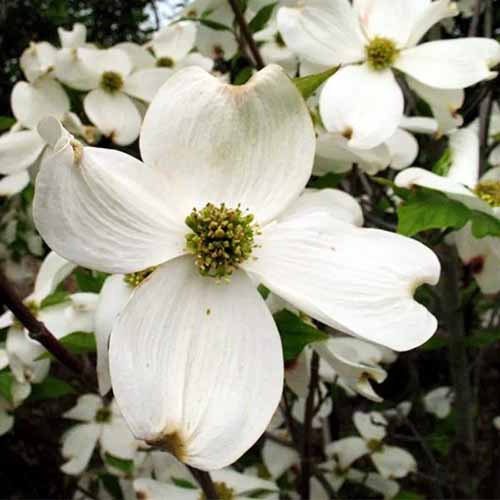

‘Cherokee Princess’
A consistent leader in Cornus cultivar evaluations, ‘Cherokee Princess’ certainly deserves its royalty.
To add ‘Cherokee Princess’ to your collection of Cornus crown jewels, you can buy one in a #3 container at Nature Hills Nursery.
5. Cherokee Sunset
The final “Cherokee” cultivar on our list goes by Cherokee Sunset™… how fitting.
Another introduction from Commercial Nursery, Cherokee Sunset™ is essentially the red-bracted version of Cherokee Daybreak™.
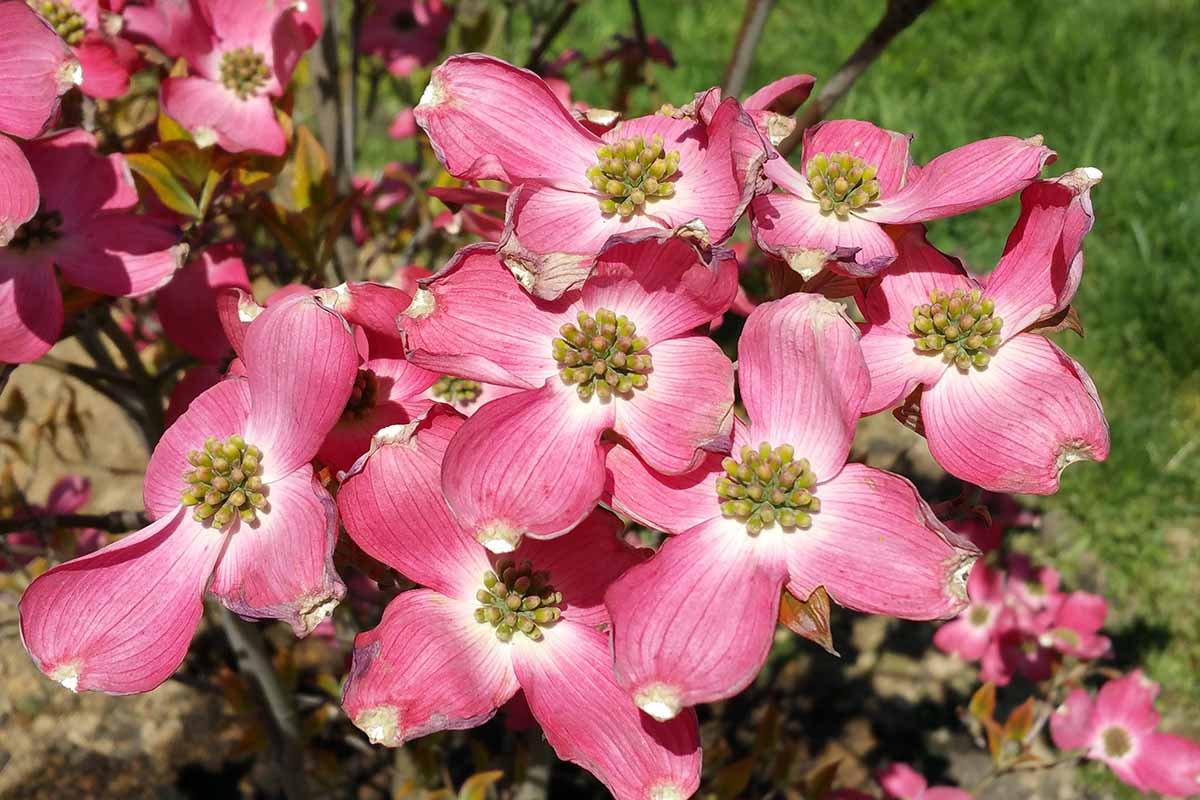

Reaching heights and spreads of 25 feet, this one also features resistance against anthracnose, as well as a vigorous growth rate.
The leaves of this variety exhibit pinkish-red new growth before maturing to green with yellow-variegated margins, which have a similar resistance to scorching. In fall, the leaves turn pink to red to purple.
Don’t get me wrong, Cherokee Sunset™ truly stands out on its own. But with a Cherokee Sunset™ to go along with your Cherokee Daybreak™, you’ll have a one-two punch of vibrant variegation and beautiful blooms.
6. Cloud 9
With densely-growing white bracts, ‘Cloud 9’ – sometimes listed as ‘Cloud Nine’ – will put a bloom lover on cloud nine, without a doubt.
Patented in 1961 by Chase Nursery in Chase, Alabama, ‘Cloud 9’ grows 15 to 20 feet tall and wide.
The aforementioned leaf bracts grow so densely that they overlap with each other, and a slow growth rate makes the plant easier to care for in sub-par conditions.
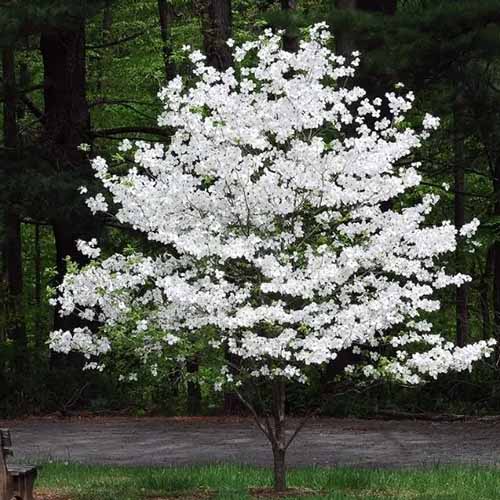

‘Cloud 9’
Speaking of, ‘Cloud 9’ tolerates ice, snow, and the cold especially well for a C. florida tree.
For gardens just on the edge of USDA Zone 5 and/or that face particularly tough winters, ‘Cloud 9’ is the cultivar for you.
Trying to get on ‘Cloud 9’? Snag one for yourself in a #3 container from Nature Hills Nursery.
7. Compacta
Not all cultivar names are these super creative, imagery-stuffed titles that sound beautiful, yet provide no helpful descriptors. Some of them will just shoot straight with you. Take ‘Compacta,’ for instance.
Reaching an itty-bitty mature size of four feet in height and width in eight to 10 years, the white-flowering ‘Compacta’ takes its sweet time to reach a compact size.
Its small frame makes it perfect for fitting into tight spots where other dogwoods may not fit.
If you’re the type of plant parent that thinks they grow up so fast – too fast – then raising ‘Compacta’ is the perfect match for your nurturing parenting style.
8. Plena
Technically, Plena, aka Alba Plena or “Pluribracteata,” is less of a specific cultivar, and more of a catch-all term for all the white flowering dogwoods with double to semi-double blooms. Yes, you read that right.
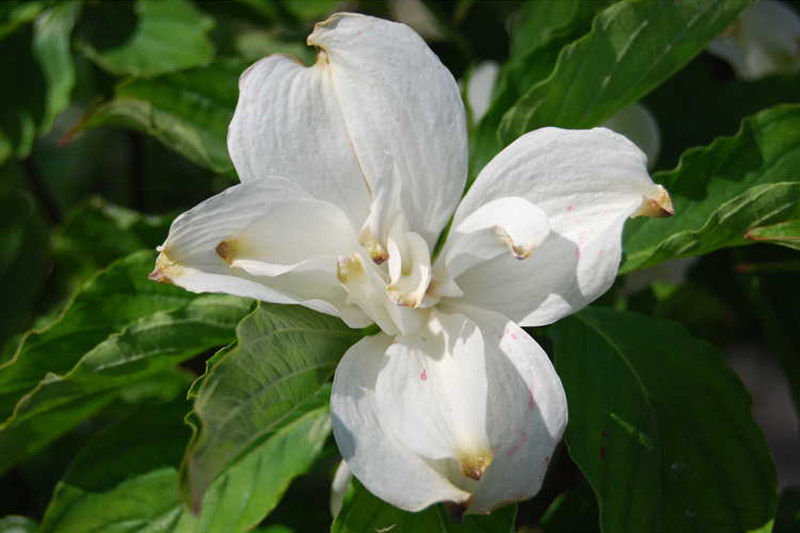

Reaching heights and spreads of 20 feet, Plena specimens exhibit up to eight bracts per flower, making each bloom look kinda rose-like.
And if that wasn’t enough, they also exhibit resistance to spot anthracnose. Good thing, too – otherwise, there’d be double the bracts for the disease to muck up.
Unfortunately, Plena specimens are fruitless. Or I suppose it’s fortunate, if you don’t want a bunch of woodland critters flocking to the drupes.
Creatures as large as deer and black bears may find the fruits tasty, so I wouldn’t blame you if this is a feature you opt for.
9. Red Pygmy
Need a small flowering dogwood with red bracts, rather than white ones? Red Pygmy®, aka ‘Rutnut’ is your shrub.
Reaching a small height of five to seven feet with a thin girth of two to five feet at maturity, this C. florida cultivar flaunts prominent rose-red flower bracts, each with white notches at their apex.
Similarly to ‘Compacta,’ Red Pygmy® can take up to a decade to reach full size.
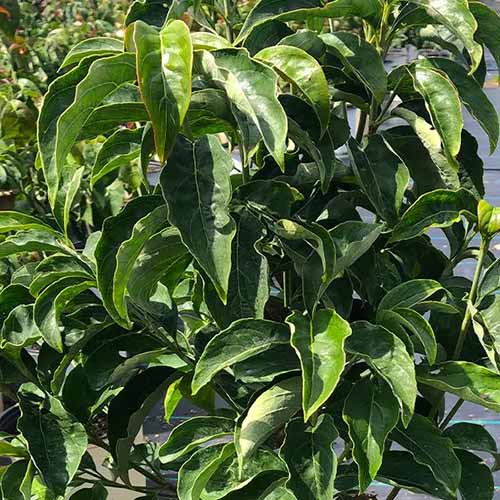

Red Pygmy
Short, skinny, and splendid: that’s Red Pygmy® in a nutshell. It’s available at Nature Hills Nursery.
10. Spring Grove
Selected as a seedling from a cemetery in Spring Grove, Cincinnati, ‘Spring Grove’ is unique in that its branches produce two to three terminal buds, rather than just one.
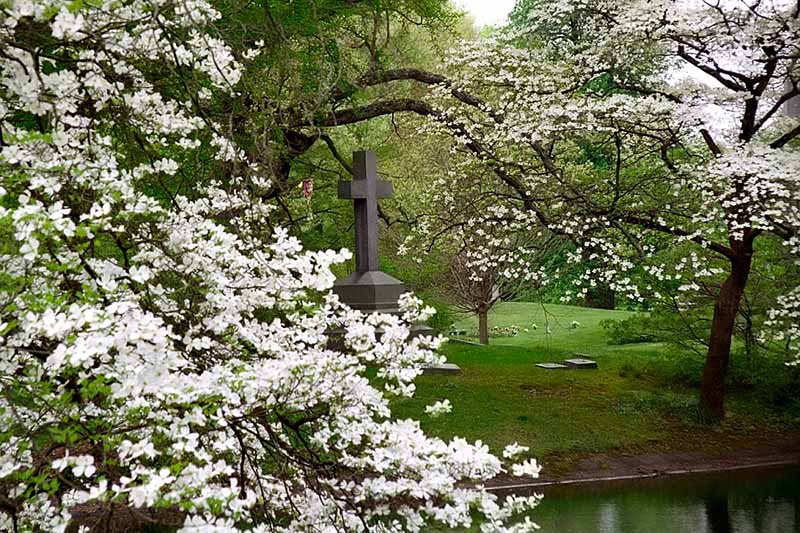

As a result, this cultivar yields a ton of blooms and fruits. The white flowers are also quite large, reaching ‘Cherokee Princess’ sizes of about five inches in diameter.
With a mature height and spread of 20 to 30 feet and beautiful, reddish-purple foliage in fall, ‘Spring Grove’ brings the aesthetics even when the fruits and flowers aren’t around.
11. Stellar
Back in the late 20th century, when dogwood anthracnose and dogwood borers were becoming significant problems, many smart horticulturalists worked tirelessly to find solutions.
The result? Specimens like those from the Stellar series.
Developed by Elvin R. Orton, Jr. in the 1970s and released by Rutgers University in the 1990s, the Stellar series of hybrid flowering dogwoods – aka Cornus x rutgersensis – were created by crossing the ornamentally awesome C. florida with the disease-tolerant C. kousa.
This breeding yielded a handful of various sterile cultivars, all with a strong resistance to dogwood anthracnose, dogwood borers, and powdery mildew.
Constellation®, aka ‘Rutcan,’ has white bracts, an upright form, and a vigorous growth rate.
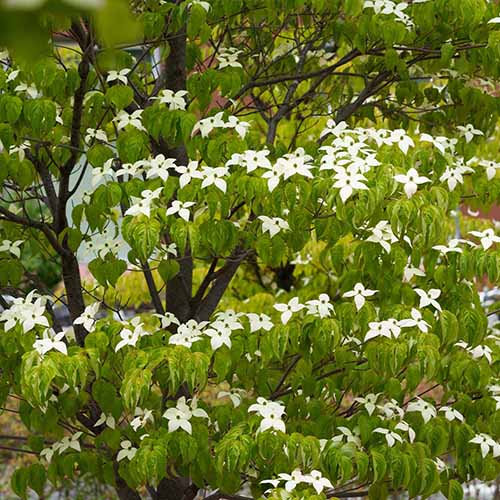

Constellation
It reaches a height of 20 feet and a spread of 17 feet, and it’s available in starting sizes of four to seven feet at Fast Growing Trees.
Stellar Pink® (‘Rutgan’) is a vigorous, pink-bracted variety with a dense, upright growing habit.
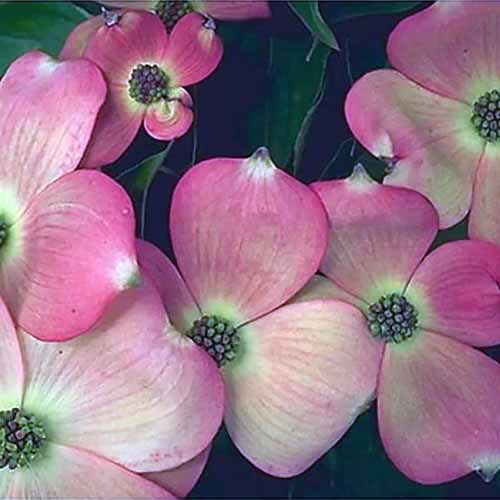

Stellar Pink
It grows to be about 23 feet tall and 18 feet wide, and you can find it available at Nature Hills Nursery.
12. Welchii
With Skittles, you can practically taste the rainbow. And with ‘Welchii,’ you can practically see it.
A white-bracted cultivar, ‘Welchii’ wields green leaves with white and pink variegation, and said foliage turns rosy red to reddish-purple in fall.
Add a yellow sun and a blue sky to the scene, and presto, you’ve got ROY G. BIV!
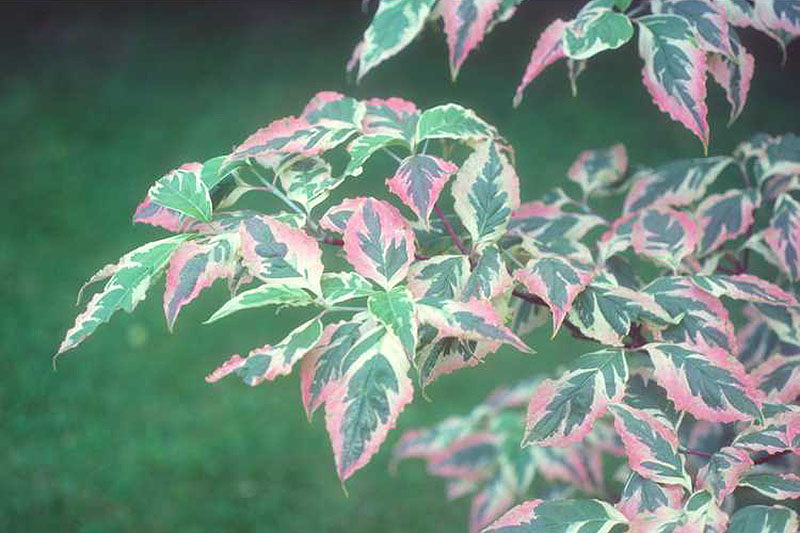

Selected by Mark Welch in the 1920s and introduced by Cole Nursery in Ohio around 1930, this tree grows 20 to 30 feet in both height and width.
And while its variegation is top-notch, it unfortunately lacks the scorch resistance of the other variegated cultivars on our list. Remember that ‘Welchii’ definitely appreciates some shade.
13. Xanthocarpa
The final entry on our list, ‘Xanthocarpa’ carves out greatness in an area untouched by the other varieties: fruit color.
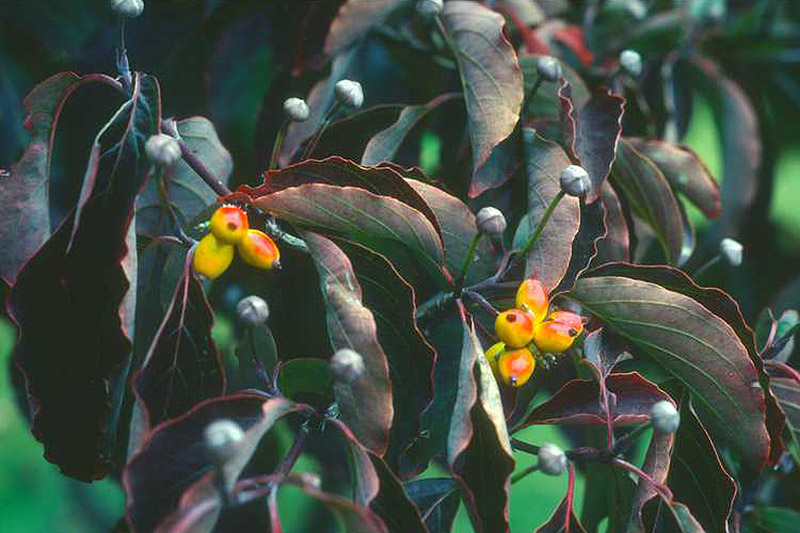

Measuring 15 to 20 feet tall and wide at maturity, ‘Xanthocarpa’ has yellow fruits, rather than the typical red ones.
This yellowness also extends to the foliage, which is tinged with a pretty yellow-green before turning a gorgeous reddish-purple in fall. The flowers are white.
In Ancient Greek mythology, golden apples had power. And in the landscape, yellow Cornus fruits wield a similar might, at least aesthetically.
It’s a Dogwood Smorgasbord!
Symbolically, anyway – you wouldn’t want to eat these plants. But hey, at least they look good!
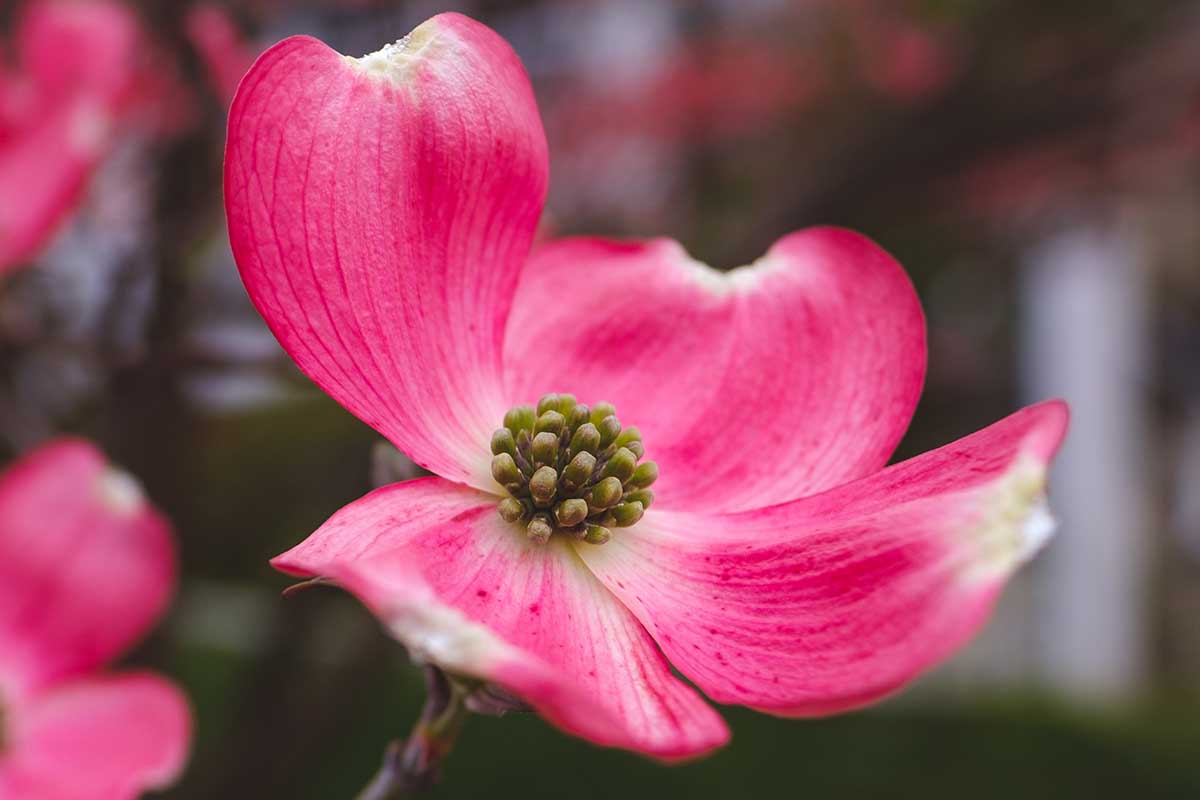

These 13 types of flowering dogwoods, while undeniably awesome, are just the beginning.
Have fun with these, and I wish you luck in searching for varieties beyond what I’ve shared on this list, if that’s what you’d like to do! It’s hard to find a bad one, that’s for sure.
Still have questions? Did I leave out any cultivars that deserved a spot in the top 13? Visit the comments section below!
To discover more about dogwoods, feast your eyeballs on these bad boys next:
- How to Grow and Care for Dogwoods
- 23 of the Best Dogwood Varieties for Your Landscape
- 15 of the Best Dogwoods to Liven Up the Winter Landscape

